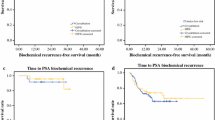Abstract
To decrease side effects observed after high-intensity focused ultrasound (HIFU) treatment for localized prostate cancer and to re-establish normal micturition in a patient population that often presents with concomitant prostate enlargement, the impact of a combined transurethral resection of the prostate (TURP) and HIFU has been evaluated. TURP and HIFU treatments were performed under the same spinal anesthesia. For the HIFU treatments, the Ablatherm device (EDAP SA, Lyon, France) was used. Selection criteria for HIFU treatment were localized prostate cancer, no previous treatment for prostate cancer, and prostate-specific antigen (PSA) ≤ 15 ng/mL at diagnosis. All patients meeting these criteria were considered for treatment and analysis. PSA nadir and stability, histology, International Prostate Specific Score (IPSS) and IPSS-quality of life, and morbidity were assessed during follow-up; 271 patients were selected: 96 in the HIFU group and 175 in the TURP plus HIFU group. A statistically significant impact was observed on catheter time (40.0 days versus 7.0 in median), incontinence (15.4% versus 6.9%), urinary infection (47.9% versus 11.4%), and the evolution of the post-treatment IPSS (8.91 versus 3.37 in average) in favor of the TURP plus HIFU group. No significant changes were observed regarding efficacy during short-term follow-up when considering a 25% retreatment rate in the HIFU group versus a 4% retreatment rate in the TURP plus HIFU group. The combination of a TURP and HIFU treatment reduces the treatment-related morbidity significantly. The patient management after a combined TURP and HIFU treatment is comparable with the management after a single TURP.
Similar content being viewed by others
References and Recommended Reading
Chapelon JY, Margonari J, Vernier F, et al.: In vivo effects of high intensity ultrasound on prostatic adenocarcinoma dunning R3327. Cancer Res 1992, 52:6353–6357.
Chapelon JY, Margonari J, Theillère Y, et al.: Effects of highenergy focused ultrasound on kidney tissue in the rat and the dog. Eur Urol 1992, 22:147–152.
Dosterhof GO, Cornel EB, Smits GAHJ, et al.: Influence of high intensity focused ultrasound on the development of metastases. Eur Urol 1997, 32:91–95.
Gelet A, Chapelon JY, Margonari J, et al.: Prostatic tissue destruction by high intensity focused ultrasound: experimentation on canine prostate. J Endourol 1993, 7:249–253.
Gelet A, Chapelon JY, Bouvier R, et al.: Treatment of prostate cancer with transrectal focused ultrasound: early clinical experience. Eur Urol 1996, 29:174–183.
Gelet A, Chapelon JY, Bouvier R, et al.: Local control of prostate cancer by transrectal high intensity focused ultrasound therapy: preliminary results. J Urol 1999, 161:156–162. Albert Gelet, who began the clinical studies for HIFU in patients with localized prostatic cancer, reports about his experiences.
Chaussy C, Thüroff S: Results and side effects of high intensity focused ultrasound in localized prostate cancer. J Endourol 2001, 15:437–440.
Thüroff S, Chaussy C: High intensity focused ultrasound: complications and adverse events. Mol Urol 2000, 4:183–187. The paper shows the development of HIFU treatment. It describes how technical development and treatment strategy during 3 years would increase efficacy and decrease postapplicative morbidity. The results showed that HIFU could be established as a clinical routine treatment for selected patients with localized prostatic cancer.
Gelet A, Chapelon JY, Bouvier R, et al.: Transrectal high intensity focused ultrasound for the treatment of localized prostate cancer: factors influencing the outcome. Eur Urol 2001, 40:124–129.
Chaussy C, Thüroff S: High intensity focused ultrasound in prostate cancer: results after 3 years. Mol Urol 2000, 4:179–182. The paper shows the development of HIFU treatment. It describes how technical development and treatment strategy during 3 years would increase efficacy and decrease post-applicative morbidity. The results were that HIFU could be established as a clinical routine treatment for selected patients with localized prostatic cancer.
Gelet A, Chapelon JY, Bouvier R, et al.: Transrectal high intensity focused ultrasound: minimally invasive therapy of localized prostate cancer. J Endourol 2000, 14:519–528.
Author information
Authors and Affiliations
Rights and permissions
About this article
Cite this article
Chaussy, C., Thüroff, S. The status of high-intensity focused ultrasound in the treatment of localized prostate cancer and the impact of a combined resection. Curr Urol Rep 4, 248–252 (2003). https://doi.org/10.1007/s11934-003-0077-0
Issue Date:
DOI: https://doi.org/10.1007/s11934-003-0077-0




